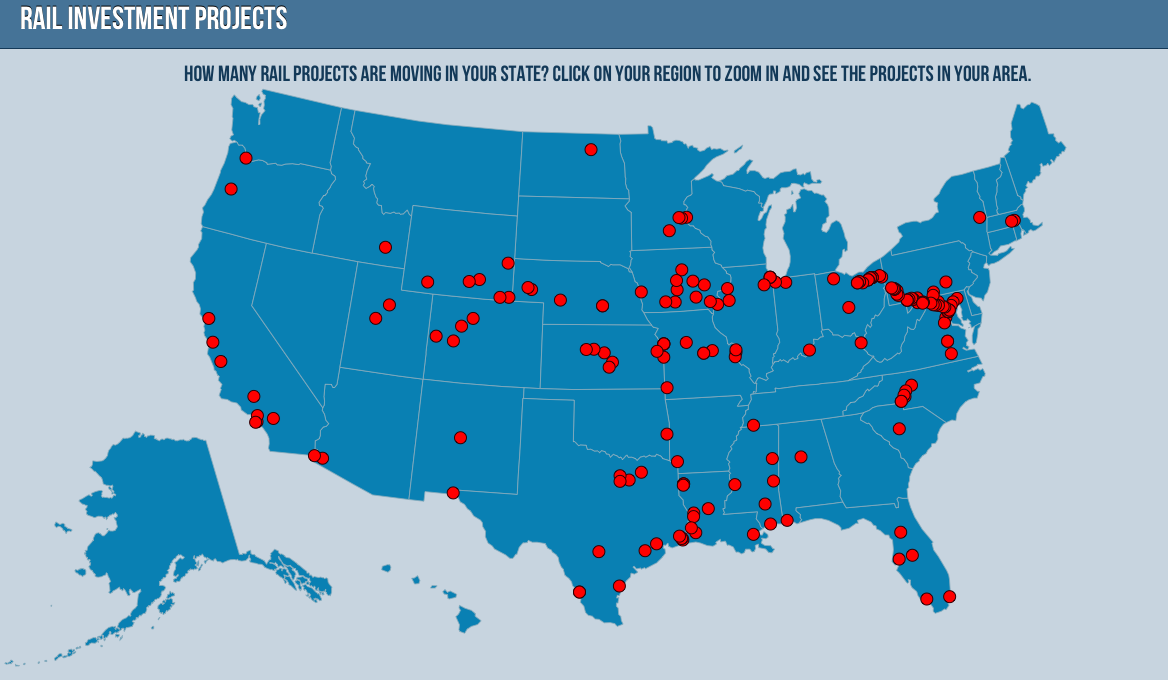AMERICAN SOCIETY OF CIVIL ENGINEERS
 Railroads are experiencing a competitive resurgence as both an energy-efficient freight transportation option and a viable city-to-city passenger service. In 2012, Amtrak recorded its highest year of ridership with 31.2 million passengers, almost doubling ridership since 2000, with growth anticipated to continue. Both freight and passenger rail have been investing heavily in their tracks, bridges, and tunnels as well as adding new capacity for freight and passengers. In 2010 alone, freight railroads renewed the rails on more than 3,100 miles of railroad track, equivalent to going coast to coast. Since 2009, capital investment from both freight and passenger railroads has exceeded $75 billion, actually increasing investment during the recession when materials prices were lower and trains ran less frequently.
Railroads are experiencing a competitive resurgence as both an energy-efficient freight transportation option and a viable city-to-city passenger service. In 2012, Amtrak recorded its highest year of ridership with 31.2 million passengers, almost doubling ridership since 2000, with growth anticipated to continue. Both freight and passenger rail have been investing heavily in their tracks, bridges, and tunnels as well as adding new capacity for freight and passengers. In 2010 alone, freight railroads renewed the rails on more than 3,100 miles of railroad track, equivalent to going coast to coast. Since 2009, capital investment from both freight and passenger railroads has exceeded $75 billion, actually increasing investment during the recession when materials prices were lower and trains ran less frequently.
Rail: Conditions & Capacity
The U.S. rail network is made up of more than 160,000 miles of track, 76,000 rail bridges, and 800 tunnels across the nation that are shared by all operators moving freight and passengers. The 565 U.S. freight railroads are categorized into 3 classes based on their distance served and earnings – 7 Class I freight railroad systems, 21 regional or Class II railroads, and 537 short line or Class III railroads. In addition to freight, the rail network hosts passenger rail service that is provided by a single intercity passenger rail provider, Amtrak, as well as operators of the nation’s 27 regional commuter rail lines.
Freight Rail
Each owner of the rail network is responsible for maintaining the condition of its track and right of way, as well as railroad bridges and tunnels. After a period of underinvestment, freight railroads nearly doubled their capital investment from 1990 to 2010 to maximize productivity by replacing aging and inefficient infrastructure as well as shedding lines that were underutilized. Regional and short line railroad operators took over many of the rail network’s “fingers” that connected customers in rural areas to the main arteries or “highways” of the Class I network. Short line railroads also connect many shippers in rural areas to main Class I and II railroads, which then transport goods over longer distances. However, many regional and short line railroad operators only maintain their segments to the most efficient level of operation, and high fixed costs in addition to new regulations can force operators to discontinue service.
Railroads transport 43% of the nation’s intercity freight and about one-third of U.S. exports, such as wheat and coal. Railroad freight tonnage growth is estimated to grow by 22% by 2035, rising from 12.5 billion tons to 15.3 billion tons. Class I railroads have initiated several public-private partnerships with states and port-connection projects to build the capacity to meet expected demand. However, as freight volumes increase relative to the network’s capacity, overall congestion on the railroad network will increase for both freight and passenger rail. Already congestion bottlenecks, in areas such as Chicago and the Northeast Corridor, are costing the U.S. economy about $200 billion a year, or 1.6% of U.S. economic output, and they will continue to escalate without adding capacity to meet future needs. To ensure freight stays productive and to capitalize on modal efficiencies, investment will be needed along nationally significant corridors and to advance intermodal options.
Passenger Rail
Although Amtrak owns only 730 miles of the 160,000 mile national rail network, they have put an increased focus on reaching a state of good repair for their assets and made necessary long-term investments when federal funding is available, or when they receive one-time grants like the American Recovery and Reinvestment Act of 2009 (ARRA). These investments and a greater on-time performance are credited for the record-high ridership on Amtrak in 2012 with 31.2 million passengers, showing almost 50% increase in ridership since 2000. In addition, commuter railroad ridership has grown more than 28% over the last decade and now exceeds 468 million passengers per year. However, ridership growth has led to some segments reaching 75% of their capacity. By 2040, Amtrak is planning for traffic in the densely populated and congested Northeast Corridor to quadruple today’s ridership, reaching 43.5 million passengers. To meet future demand in the Northeast Corridor for both Amtrak and the eight commuter railroads that use the corridor, estimated investments are about $10 billion over the next 15 years to achieve a state of good repair and to increase train capacity by 40%. Maintaining adequate track capacity to address expanding passenger and freight needs is among the largest challenges in creating a competitive passenger railroad network.
See full interactive map here.
And read more about the ASCE’s Assessment of America’s Rail Infrastructure here.
About the American Society of Civil Engineers (ASCE)
www.asce.org
““Founded in 1852, the American Society of Civil Engineers (ASCE) represents more than 147,000 members of the civil engineering profession worldwide, and is America’s oldest national engineering society. ASCE’s vision is to position engineers as global leaders building a better quality of life…Comprised of Regional Councils, Younger Member Councils, Sections, Branches, Student Chapters and Clubs and International Student Groups, the Society and its volunteers are fully engaged in making this a better world by design.”
Tags: American Society of Civil Engineers, Amtrak, ASCE, Freight Rail, Passenger Rail, Report Card for America's Infrastructure







 RSS Feed
RSS Feed